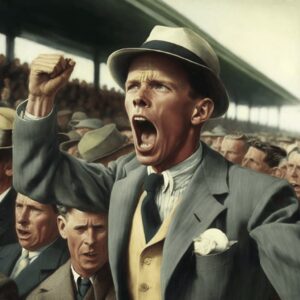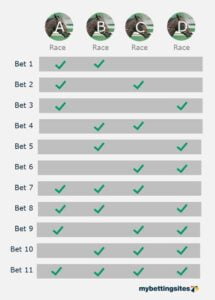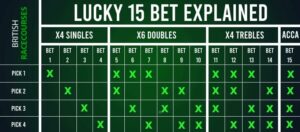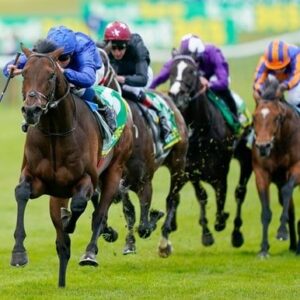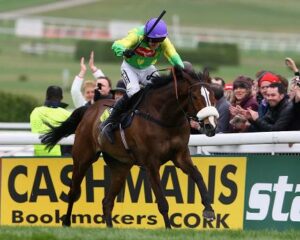Strategies For Finding Big Price Each-Way Bets
Finding high price each-way bets is potentially a great way to increase your winnings in horse racing. The key is to implement a solid strategy considering different factors, such as the horse’s form figures, the race conditions, and the betting market.
This article will provide a comprehensive guide to each-way betting with a specific focus on UK horse racing markets.
We will explain everything you need to know about each-way betting. This will begin with the most basic introduction for betting beginners.
By the end of the article, we will give specific details about the kind of horses to look for.
Horses can produce huge payouts at amazing odds. Read on to discover more…
Introduction to Each-Way Betting
Each-way betting is a popular form of betting in UK horse racing. It involves placing a bet on a horse to either win a race or place within a specific number of runners, usually the top three or four.
This type of betting offers a safety net, as you can still win money even if your horse doesn’t win the race. This comprehensive guide will explore each-way betting in-depth, including its advantages and disadvantages, ideal race conditions, and strategies for finding big-price each-way bets.
Whether you’re a seasoned punter or new to horse racing, this guide will provide valuable insights and tips to help you improve your betting success. So, prepare to learn about each-way betting and take your betting skills to the next level.
What are Each-Way Bets?
An each-way bet is a type of wager placed on a horse in a race. It involves two separate bets, one to win and one to remember. The place bet wins if the horse finishes in the top positions, typically the top three or top four, depending on the number of runners. The win bet wins if the horse wins the race.
For example, if you place a £10 each-way bet on a horse at odds of 10/1, you will receive £100 if the horse wins the race and £20 if the horse places in the top positions. This means that an each-way bet gives you a chance to win money even if the horse doesn’t win the race. Wach way bet is a popular choice among horse racing fans.
It’s important to note that each-way bets are only available for specific races, usually those with many runners. It’s also essential to check the terms of each-way betting with the bookmaker you are using. Some bookmakers may have different rules for the number of runners required or the fraction of odds paid for each-way bets.
Understanding Place Odds for Each Way Bets
Place odds in horse racing are traditionally determined by the number of runners in a race. For example, in races with 5 to 7 runners, place money is typically paid for the first two horses to finish. In races with 8 to 15 runners, place money is paid for the first three horses to finish. For handicaps with 16 or more runners, place money is typically paid for the first four horses to finish.
Place odds terms vary between races, with some offering 1/4 odds and others offering 1/5 odds. This refers to the fraction of the win odds that the bettor will receive for a placed horse. For example, in a race with 1/4 odds place terms, if a horse has win odds of 8/1, the bettor will receive 2/1 for a placed finish. In a race with 1/5 odds place terms, the same horse would receive 1/5 of the win odds, or 8/5, for a placed finish.
The weight for age races typically have lower place terms, with most bookmakers limiting their place money to the first three horses. However, some bookmakers may offer extra place promotions, particularly in large field handicaps or by treating weight for age races similar to handicaps. This is done by offering place terms down to 4th place as if the race was a handicap.
It is important always to check the exact place terms offered by individual bookmakers, as they greatly vary. Taking advantage of extra place promotions is a key strategy for maximising your each-way betting profits.
Why Bet on Big-Priced Horses?
Each-way betting in horse racing provides an opportunity to win big even if your horse doesn’t cross the finish line first. When you place an each-way bet, you’re essentially placing two bets – one for your horse to win and another for your horse to place. The place portion of the bet pays out if your horse finishes in the several top positions, usually in the top three or four.
This is why betting on big-priced horses can be a smart move. The bigger the odds, the more you stand to win if your horse places. Just the same as for a winning bet.
Betting on a big-priced horse means you can earn payouts for both a horse winning the race and finishing in the top positions, known as “place payouts.” This is because each-way bets consist of two separate bets, one for the horse to win the race and another for the horse to place in the top positions.
If the horse wins the race, you’ll receive both the win payout and the place payout. You’ll receive only the place payout if the horse doesn’t win but still places. By betting each way, you’re increasing your chances of earning a return on your investment.
Here’s an example:
Imagine you place a £10 each-way bet on a horse priced at 10/1 to win a race. If the horse wins the race, you will receive two payouts, one for the win bet and one for the place bet.
The win bet pays out at 10/1 odds, so your winnings will be £100 (10 x 10). The place bet pays out at a fraction of the odds, for example, a fifth or a quarter, so if the place bet pays out at a fifth of the odds, you will receive £20 (10 x 1).
You will receive £120 (100 + 20) if the horse wins the race.
If the horse finishes placed in second, third, or fourth place, depending on normal terms, you will only receive the place bet payout. So, if the place bet pays out at a fifth of the odds, you would receive £20 (10 x 1).
This example shows how each-way bets can potentially increase your winnings compared to just betting on the horse to win, as you receive payouts for both the win and place bets.
Bookmakers can also underestimate big-priced horses, providing an opportunity for savvy bettors to cash in. When you bet on a big-priced horse, you’re taking a calculated risk, but the potential payout can be significant.
In conclusion, each-way betting allows you to win big even if your horse doesn’t cross the finish line. Betting on big-priced horses can be smart as it provides the chance to win big payouts even if your horse only places. Just remember always to do your research and consider the risks involved.
Is It More Profitable To Bet at Big Odds?
Regarding horse racing, many punters believe that betting on big-priced horses is more profitable in the long run. Each-way betting provides a safety net because you get a return if the horse finishes in the top places.Betting on big-priced horses can bring greater returns if they win.
Research has shown that the odds of the favorite winning a race are usually low, around 30-35%. However, the odds of the outsider winning are much higher, up to 60-70%. In other words, the bigger the odds, the higher the chance of a big return.
A study by a professional gambler, value betting expert and author, Joe Dancer, supports this idea, showing that betting on horses with odds of 10/1 or higher has higher profitability overall. However, this is only true when combined with expert analysis.
It’s important to remember that betting on big-priced horses is not a guaranteed way of making a profit. Every bet carries risk, and while the odds may be higher, the chances of losing are also greater. It’s easy to run up a long-losing sequence when betting at big odds. Therefore, it’s crucial to do your research before placing your bet.
Optimum Race Conditions for Each-Way Betting
Optimal race conditions greatly affect your chances of making a profitable each-way bet. When considering which races to bet on, factors such as the number of runners, the course, weather, and the going conditions all play a role.
The number of runners in a race impacts the place terms offered by bookmakers, with more runners resulting in reduced place terms. Courses with a reputation for producing longer-priced winners, such as Cheltenham, may offer better each-way value than courses where favorites frequently win.
Weather conditions also have a significant effect on the outcome of a race. A dry, fast surface is ideal for horses with a high cruising speed, while a soft surface help horses with a strong finishing burst. The going conditions are also important, as horses perform differently on different types of ground.
It’s worth noting that certain types of races, such as handicap races and hurdle races, offer better each-way value. These races have a wider pool of more evenly matched horses, leading to longer odds and improved place terms.
When betting on each way, it’s important to consider these race conditions and make informed decisions based on your research. By understanding the different factors that impact the outcome of a race, you can increase your chances of making a profitable each-way bet.
Best Types of Races for Each-Way Betting
Each-way betting is a great way to maximize your chances of winning while reducing your risks. However, not all races are equally good for this betting strategy. In this section, we’ll explore the best types of races for each-way betting and why they are particularly well-suited to this approach.
Handicap races are a great choice for each-way betting. These races are designed to level the playing field by assigning weights to the horses based on their past performance. This means that even relatively unknown horses can still perform well and offer good value for each-way bets.
Long-distance races, can also be good for each-way betting. The longer the race, the more chance there is for something unexpected to happen and for less-favored horses to make a strong showing. This can result in higher place payouts for each-way bets.
Another great option is to race with a large number of runners. The more horses in a race, the greater the chance of a big-priced horse placing. This option makes each-way betting a smart choice for these types of races.
When considering each-way bet, it’s important to research the conditions of the race and the horses involved. Some horses may perform better in certain conditions, such as heavy rain or strong winds. Look for races with conditions that may give an advantage to less-favored horses.
By carefully selecting the right races and horses, each-way betting can be a lucrative strategy. Whether you’re an experienced punter or a beginner, it’s worth considering each-way bet when planning your betting strategy.
Field Sizes for Each-Way Betting
When considering each-way betting, it’s important to consider field size. The field’s size in a race directly impacts the odds offered and the potential returns from an each-way bet. A larger field often means more competition and, therefore, shorter odds, while a smaller field may result in longer but less competition. Understanding the impact of field size is crucial when trying to find the best each-way betting opportunities.
Field sizes in horse racing vary greatly, with some races having just a handful of runners while others having 20 or more. It’s essential to take note of the field size when assessing the race and the betting market. For example, if you place an each-way bet on a horse in a small field, they are likely to finish in a place position. On the other hand, in a larger field, it may be more challenging for a horse to secure a place, but the odds offered may be longer.
Research suggests that each-way betting is generally more profitable in races with smaller fields. A study of UK horse racing found that the average odds of a placed horse in a race with a field size of fewer than ten runners were significantly higher than in races with larger fields. So, it’s worth focusing on races with smaller field sizes if you’re looking to maximize your returns from each-way betting.
Races to Avoid for Each-Way Bets
Regarding each-way betting in UK horse racing, there are certain races to avoid to maximise your chances of success. A well-researched approach is crucial in minimizing risk and maximizing returns. Here are some races to steer clear of when placing each-way bets.
- Handicap Races with Big Fields: With large numbers of horses competing, finding value in the place market can be difficult, even with good odds.
- Horses with High-Profile Jockeys: When a top jockey rides your horse, the odds can drop significantly, making it harder to find value in the place or win the market.
- High-Class Races: Races featuring the best horses and jockeys can be tough to find value in, as the odds are often well-established.
- Novice Races: Races for inexperienced horses can be hard to predict and may not offer good value in the place market.
By avoiding these types of races, you can improve your chances of success with each-way betting in UK horse racing. Remember, each race is unique, and it is important to conduct thorough research to make informed decisions.
Strategies for Finding Overpriced Horses
As for each-way betting, finding overpriced horses can lead to big payouts. But how can you identify these hidden gems in a crowded field of competitors?
To help you find overpriced horses, we’ve compiled a list of effective strategies that successful punters have used.
Using these strategies and keeping up-to-date with the latest news in the racing world can increase your chances of finding overpriced horses.
This will maximize your profits from each-way betting.
Researching Form and Statistics
Form refers to a horse’s recent performance in races. Analyze past races to understand the horse’s running style, strengths, and weaknesses. Look for improvements or downturns in form. Factors to consider include:
- Finishing position in past races
- Time of completion in past races
- Going conditions in past races
- Distance of past races
Check the Horse’s Stats
Statistics help provide a more detailed view of a horse’s performance.
The only issue with statistics is that you could consider hundreds of different numbers when judging a horse. Some of these are far more likely to be more relevant, more often, than others.
We suggest you focus on the statistics most likely to give you insight into any horse. These may include:
- career strike rate (including by race type, distance, course, and ground)
- recent form numbers (horses finishing out of the first 6/7 in recent starts under similar conditions are unlikely to win)
- stable form in the past 14 days (win and place percentages)
- handicap rating if a handicap race
- jockey stats in this course
- trainer stats at this course
- draw bias stats (some courses have huge biases at specific distances)
- days since the last run
As stated above, the complete list of stats that might affect a race is vast. Only highly complex software such as Racing Experts REX model and similar stat engines can compute this amount of data to draw accurate predictions.
For a normal human brain, perhaps with a calculator to help, focusing on the main 10-20 likely significant stats is advisable.
Use online resources like Racing Post to access a wealth of stats and data to help you discover your needed information.
Use the Information to Your Advantage
Form and statistics are useful tools to help determine the potential of a horse. However, they’re just one part of the picture.
Always consider the horse’s overall condition, the field size, and the competition. Use the information to find value bets and increase your chances of winning.
Identifying Good Jockeys and Trainers
Betting on horse racing can be challenging, but one way to increase your chances of success is by identifying top jockeys and trainers. These professionals play a vital role in the horse’s performance, and their track record can give you valuable insights into its potential. To identify good jockeys and trainers, you should consider the following factors:
- Jockey Win Percentage – A jockey with a high win percentage indicates a knack for getting horses to cross the finish line first. Consider checking their recent statistics to see if they have been riding well.
- Trainer Strike Rate – A trainer with a high strike rate has a good record of getting their horses to perform at their best. Please take the trainer’s win rate in the past year and compare it to other trainers.
- Course and Distance Specialists – Some jockeys and trainers have particular expertise in riding at specific tracks or over certain distances. Look for those with a strong track record at the racecourse you are betting on.
- Jockey and Trainer Combination – It can be valuable to look at the statistics of a jockey-trainer combination, as some pairs have a history of working well together.
By considering these factors, you can make informed decisions and increase your chances of success when betting on each-way horse races. It’s important to remember that no jockey or trainer can guarantee a win, but their track record gives you a better understanding of the horse’s potential.
The Best Jockeys and Trainers For Each-Way Betting
Like in most sports, some trainers are famous and very well-followed. The same thing applies to jockeys. Those that have constantly delivered winners at a high level will always be the most popular.
This popularity is directly reflected in the betting markets for events in which their horses run. And by that, we mean their odds tend to be shorter than they would be if the horse were trained or ridden by someone else.
Therefore, following famous trainers and jockeys is usually a bad idea. This is backed up by the stats, with all the leading Uk trainers and jockeys making a loss to a level stake almost every year.
But this fact of life also presents an opportunity for some of us. There will be a knock-on effect in any race where famous connections artificially reduce the odds of their horse. The odds of other horses in the race are bigger than they should be to balance the market.
And it is identifying horses that not only have a good chance of a good run but are also overpriced in the market that is the Holy Grail of finding great value in big-priced horses.
For this reason, when looking for a horse at a good price, you should look for able and competent trainers and jockeys who ARE NOT world-famous or even just seen as being a level or two above today’s opposition.
Their horses can still win, of course, and many wills.
But if you spend all your time backing John Gosden or Aidan O’Brien horses ridden by Frankie Dettori or Ryan Moore, you will soon realize it is not profitable in the long term.
Following Market Movers
You can make each-way betting in UK horse racing even more exciting by keeping an eye on market movers. Market movers refer to horses whose odds change rapidly, often due to heavy betting activity. This can indicate insider knowledge or a horse’s sudden surge in form.
To stay on top of market movers, you can use various online resources such as racecards and betting sites . These resources will provide up-to-date information on the odds of each runner and any fluctuations in those odds. You can also sign up for bookmakers notifications, alerting you to any significant changes.
Another way to stay informed is to follow racing tipsters and industry experts on social media or their websites. These professionals often have access to insider information and can provide valuable insights into a horse’s form and chances of success. Following expert tipsters is a good strategy if you want to boost your horse racing results,.
It’s important to remember that market movers are not a guarantee of success. Many factors can influence a horse’s odds and performance, such as changes to the going or the weight they are carrying. So, while following market movers can be a useful tool, it should always be combined with research and understanding the race and the runners involved.
“Betting on the market movers can add an extra element of excitement to each-way betting,” says professional UK horse racing tipster Tom Wilson. “But it’s crucial to use this information wisely and not solely rely on the odds shifting.” (Wilson, 2020).
By keeping an eye on market movers and combining this information with your research, you can make more informed decisions when placing your each-way bets in UK horse racing.
Monitoring Betting Trends
Betting trends can be a valuable tool in making informed decisions regarding each-way betting in UK horse racing. By keeping an eye on popular bets and the amount of money being placed on certain horses, you can better understand the market and each runner’s potential.
One way to monitor betting trends is to use online betting exchanges. These allow you to see real-time information on the bets, including the odds and the amount of money being wagered on each horse. Using this information, you can identify horses attracting significant betting support.
It’s important to keep in mind, however, that betting trends are not a guarantee of success. Many factors can influence a horse’s odds and performance, and what may seem like a popular bet could still end up losing. As with market movers, it’s crucial to combine betting trends with your research and understanding of the race.
“Betting trends can be a useful tool, but they should always be used in conjunction with a thorough understanding of each runner’s form and prospects,” says professional UK horse racing analyst Sarah Smith. “By combining betting trends with your own research, you can make more informed decisions and potentially increase your chances of success.” (Smith, 2021).
By monitoring betting trends and combining this information with your research, you can stay ahead of the game regarding each-way betting in UK horse racing.
Things to Look for When Searching for Big Odds Bets
Betting on horse racing can be an exciting way to make some money while enjoying the sport potentially. However, it’s important to be knowledgeable about the horses, trainers, and conditions that may affect the outcome of a race.
When searching for big-odds bets, there are several key factors to consider. This guide will provide insight into what to look for, including:
- inexperienced horses
- horses with previous good form
- horses returning to preferred conditions
- horses after a stable switch
- horses from struggling stables finding form
- horses from unfashionable yards
- horses with deliberately poor recent runs
Understanding these factors can increase your chances of potentially hitting it big with a big odds outsider.
Inexperienced Horses
Inexperienced horses, or those with limited racing experience, can sometimes offer the biggest odds for bettors. While it may seem counter-intuitive to bet on a horse with limited experience, several factors can work in its favor.
Firstly, inexperienced horses often have fresh legs, having not been over-raced. This can give them an advantage over more experienced horses who may have run in several races already and be more ‘exposed.’
Additionally, inexperienced horses are sometimes overlooked by the betting public, leading to higher odds for those who take a chance on them.
Another factor to consider is the horse’s breeding and training background. A well-bred horse with top-notch training can often overcome a lack of racing experience and perform well in its first few races.
By carefully considering these factors, punters can increase their chances of finding a winner at big odds.
Horses with Good Previous Form
When searching for big odds bets, it’s always a good idea to watch horses that have shown good form in the past but has recently been quiet.
These horses may have run poorly, but many can bounce back and return to their old form. Keep a close eye on horses that have run well at the track in the past or those that have won at a similar distance.
After a series of bad runs, a horse might have a greatly-reduced handicap mark that doesn’t reflect the true ceiling of its ability. And after a series of unplaced runs, this horse will likely be available to back at decent odds. Certainly, the odds are big enough for each-way bet.
Horses Returning to Preferred Conditions
Never understood the cliche horses for courses? This saying is rooted in betting on horse racing.
Pay close attention to horses that have run well against better-class opposition over the same course distance as the upcoming race. Every racehorse in the world has an ideal distance and course. If a horse has been running over the wrong distance or course and now returns to optimum conditions, it can be a huge pointer to a good value bet.
Just because a horse has run well over today’s course doesn’t mean it definitely will again this time. But out-of-form horses have a huge propensity to bounce back over their preferred course and distance. Far more so than in conditions that aren’t as suited.
Furthermore, horses are extremely intelligent animals with great memories. If a horse remembers this course and that he made a big fuss about him afterward, he will remember. And be in a positive frame of mind.
By keeping track of these factors, you’ll better understand which horses might provide good value for your each-way bets, even when the bookies and the rest of the market haven’t identified the same information.
Horses with Stable Changes
Switching stables is a common and well-known signpost for a horse to improve. There are many reasons a stable switch can ignite sudden improvement. This can include a change in diet suiting the horse better. Or the different training regime is suiting the horse physically.
Even mentally, a horse can improve significantly with a switch of trainers. Like people, horses can get depressed, bored, or stagnate in a routine they’ve been in for a long time. The training regime is different in every trainer’s yard. New surroundings, humans, and stablemates around a horse can reignite their enthusiasm.
A lot of horses will improve within their first three runs of a stable switch. Some might take a little longer. But if moving yards is to generate a sudden performance improvement, it will usually be in the first three runs.
For that reason, keep an eye on horses who recently moved yards. They don’t necessarily need to go to a better trainer. The horse may have become disillusioned at their former yard,, and any switch might change fortunes.
As a result, these horses present a popular angle for each-way value seekers. Following stable switchers could be considered a simple horse racing system that works. Any horse that has recently moved between yards should feature in your analysis.
Horses from Struggling Stables Finding Form
In horse racing, stables can experience fluctuations in performance, just like any business. It’s important to pay attention to horses that come from stables that have recently been struggling, as they can be overlooked by the market and provide great value for each-way bets.
One reason for a dip in stable form is an illness. If a cold-like bug spreads through a whole stable of horses, it can greatly affect their performance. This type of illness can spread quickly and cause a significant drop in form for multiple horses.
The poor feed can also be a source of the dip in a stable form. If the feed the horses are being given is of low quality or contains contaminants, it can lead to health issues. This can include low energy, muscle loss, and weakening in blood vessels which might lead to rupturing, and numerous other complaints.
Contaminated bedding can also play a role in a dip in a stable form. If the straw bedding is dusty or contains other contaminants, it can cause irritation and inflammation to the horses’ sensitive airways and lungs. This can lead to a severe decline in performance. Imagine trying to win a 400m race with a sore throat and congested chest and not going to happen!
By keeping an eye on horses from struggling stables, you may find great value in your bets. Just because a stable has been struggling lately doesn’t mean its horses can’t suddenly find form. So don’t overlook these horses when analyzing the field for your each-way tips.
Horses from Unfashionable Yards
Horses from unfashionable yards can often be overlooked by the market and provide great value for each-way bets. These horses are trained by less well-known trainers or have less of a reputation in the racing world, but this doesn’t mean they can’t be competitive.
Unfashionable yards may not have the latest equipment or the best facilities, but they can still produce horses that are in top form. The trainers at these yards often have a wealth of experience and knowledge that they use to get the most out of their horses.
It’s important to remember that horses are individuals and have their unique qualities, regardless of where they are trained. A horse from an unfashionable yard may have a different training regime or routine that suits it better than a more well-known yard.
By keeping an eye on horses from unfashionable yards, you can often find horses flying under the radar and provide great value for each bet. So don’t overlook these horses when analyzing the field, as they could surprise you and provide a winning bet.
Horses with Deliberately Poor Recent Runs
Unscrupulous trainers or owners may deliberately allow a horse to run poorly to lower its handicap mark and qualify it for weaker races carrying lower weights. This can artificially inflate the odds as the public betting market will not be aware that the horse has not been trying, which is against the racing rules but occurs regularly.
Horses that have been running badly and suddenly become heavily supported in the betting markets, often at a lower handicap rating than they usually compete off of, are another red flag. Watching videos of the horse’s recent runs can provide insight into its form. If a horse starts very slowly, the jockey uses questionable tactics or effort in the saddle, or the rider seems to look for trouble rather than looking for gaps to run through, it may suggest that the horse was not running on its merits and that a big gamble might be attempted soon.
By being vigilant and looking for these signs, bettors can position themselves to take advantage of these opportunities and potentially find value in horses that others may overlook. Of course, there is never a guarantee of success, but by staying informed and being aware of these factors, punters can increase their chances of finding each-way bets and winners at high prices.
Finding the Right Races to Bet In
Starting in horse racing betting can be overwhelming. Learning which races to bet in when looking for each-way bet is a skill that can be taught. This section will guide you through selecting the best races to place your bets on and begin that learning journey.
To become a good each-way punter, it’s important to understand the different types of races and how they set up for each-way bets.
So, get ready to start learning how to choose the best each-way races to bet on. We’ll ensure you have all the information you need to improve your chances of consistent success.
Ideal Field Sizes For Each-Way Betting
Understanding field size limits and how they affect each-way betting is a key strategy for making a profit. In general, the more runners in a race, the greater the chances of a big-priced runner filling one of the each-way places. For example, in a race with 5-7 runners, bookmakers usually pay two places, while in a race with 8-15 runners, they pay for 3 places. In races with 16 or more runners, they may pay four places or more, depending on the individual bookmaker’s terms.
It’s important always to check the exact terms for each race, as bookmakers may offer different terms for non-handicap and handicapped races. Generally, betting each way in fields just over the threshold for a different place is a smart strategy. For example, betting on five runners each way gives you two places, while betting on 7 runners each way still gives you only two places. So it is safer and easier to profit from betting on five runner fields.
The same logic applies for each-way bets for three places, where fields of 8-9 horses are preferred. And based on standard four place handicap terms, a field of 16-17 runners is easier than one with 30 runners if there are only four places available. However, bookmakers may adjust the traditional each-way limits and models to attract more business. For example, some bookmakers might pay ten places or more each way for the 40-runner Grand National, a huge betting race, but even at small meetings, you may find races with 12 runners paying four places with bookies like Skybet. These offers provide a huge edge for each-way punter and should be considered.
It’s important to be aware of these field size limits and adjust your each-way betting strategy accordingly. By focusing on races with the right number of runners, you can improve your chances of making a profit. And by keeping an eye out for special offers from bookmakers, you can give yourself an even bigger advantage.
Race Types to Focus On
When choosing races to place each-way bet, it is important to focus on specific race types that are known to provide the best opportunities for a successful bet.
One race type of focusing on is handicap races. Handicap races are where horses are assigned weights to carry based on their ability. This creates a level playing field often resulting in tight finishes and unpredictable outcomes. This makes them ideal for each-way betting, as there is often value found in the longer odds.
Based on what we learned in the previous section, a five runner or eight runner handicap, right on the threshold for an extra qualifying place, could be a perfect race for an each-way pick.
Another race type of focusing on is the Class 2 and 3 races. These races often feature horses that are on the up and improving but are not yet at their peak. Unknown quantities in racing are often priced higher than they should be, providing excellent value for each-way bets if you choose right.
Finally, it is also worth looking at races that feature a mix of both young and older horses. These races are often unpredictable, with younger horses providing speed and older horses providing more nous and experience. This can make them ideal for each-way betting. You can often find value in the bigger-priced horses in a race where the outcome is hard to call.
When focusing on these race types, it is important to remember that each-way betting is a long-term strategy and that success is not guaranteed in every race. However, focusing on these types of races increases your chances of finding value and making a successful each-way bet.
Race Types to Avoid for Each-Way Betting
When choosing the right races for each-way betting, it’s not just about finding the right field sizes but also avoiding certain types of races that can prove difficult to make a profit from. Here are some race types to avoid:
Races with two clear Favourites
Races with two strong favorites clear in the betting are tough for each-way betting. Taking on one fancied horse is ok, but taking on two that seem to have a big advantage is risky. Even if one of them blows out, the other is likely to win or, at the very least, take up one of the available places. And if they both run to form, they will likely fill the first two places. In a race with two places, this is a deal breaker. In a race with three places, it means you are playing a risky game. And even in a race paying four places, you could be competing with 14+ other horses for just two places on the podium. Avoid this type of race.
Large Field Handicap Races
Handicap races can be tricky as they are often run with large fields and can have many runners with a similar forms. This makes it difficult to determine which horses have the best chance of finishing in the places. Extra place terms with some bookies can alleviate this problem. But if that is not the case, avoid races with over 20 runners.
Races with Little Form
Races with few runners with form or a large number of runners making their debut can also be difficult to predict. It can be difficult to determine which horses are likely to finish in the places.
Sprint Races
Races 6 furlongs or less in the distance, often referred to as sprints, can be more difficult to predict than longer races. Because of the shorter duration of the race, the impact of a bad start, poor position, or traffic problems is multiplied. In a long distance race, jockeys have more time to overcome these issues. Losing half a second in a 60-second race is more detrimental than in a 150-second race. As a result, each-way betting on sprint races can be challenging. Avoid them in case of any doubt.
Maiden Races
A maiden race is a race for horses that have not yet won a race. These races can be unpredictable and are best avoided when betting each way. Inexperienced horses often cause unforeseeable outcomes for a multitude of reasons. Unless there are a lot of positive factors, maidens are usually races to avoid as each-way betting strategy.
Non-Handicap Races
Handicap races are races in which each horse is assigned a weight to carry based on its recent performance. This weight is meant to level the playing field and give each horse an equal chance of winning. Non-handicap races, on the other hand, are in which all horses carry the same weight. Sometimes these races do include a sex allowance to benefit female horses, an age allowance to favor younger horses, or penalty weights for winners of previous races. These can make the race even more complicated, particularly for non-expert gamblers.
It’s important to remember that there are always exceptions to these general guidelines, and you should always consider the specific circumstances of each race before making a bet. Bookmakers will sometimes offer enhanced place terms for specific races, so it’s always worth checking the terms before placing your bet.
Risks of Betting on Horses at Big Odds
Betting on horses at big odds can be tempting for a large payout, but it is important to understand the risks involved. This section will explore the potential dangers of placing bets on horses with long odds and how to mitigate those risks.
Whether you are a seasoned punter or just starting, it is crucial to consider the odds and understand the potential risks before making a bet. This section will provide valuable insight into the world of betting on horses at big odds, helping you make informed decisions and potentially avoid costly mistakes.
Bookies Often underprice very Long-Odds Horses
At the bottom of the market, it’s common to see horses offered at odds lower than their true odds. Bookies can get away with offering 50/1 or 100/1 about an outsider that should be 300/1 because it still seems like a high price.
The reality is that these horses often have a far lesser chance than these odds imply. Sometimes these horses are underpriced by 5-10 times their real chance.
Bookies do this to protect big payouts and boost their profits. But if you look at a 100/1 shot and then check its odds on a betting exchange, you’ll often see that horse available to bet at several times the bookmaker’s odds.
Therefore, betting big odds with bookies is often a recipe for disaster. Over some time, unless you are very lucky, this discrepancy will guarantee the bookie comes out on top.
You can mitigate this issue by utilizing betting exchanges to get closer to the ‘real odds’ a horse should be. Just using exchanges to be wise in situations where bookies are seriously undervaluing a horse can help you address this balance.
Using Betting Exchanges To Get Better Odds
The use of betting exchanges is a smart strategy for horse racing bettors who want to increase their potential profits. Betting exchanges offer the opportunity to find better odds compared to traditional bookmakers.
This is because the odds set by betting exchanges are determined by the punters, not by the bookies. When you place a bet on a betting exchange, you’re betting against other punters, not against a bookmaker.
This means that betting exchanges allow for more competitive odds, as the open market sets the prices.
Bookmaker odds are set by the individual bookmaker with their profits as the universal aim. Do not expect or assume bookies’ odds, to be fair!
Additionally, betting exchanges offer the ability to lay (bet against) a horse winning a race, giving you more control over your bets.
Betting exchanges also offer the opportunity to trade during a race, allowing you to make quick decisions based on the live action.
This is especially useful when betting on live or in-play markets, as it allows you to react to changes in the race as they happen.
You can lock in profits, reduce losses or even trade out for a profit, even if the horse you backed does not win the race.
It is important to note that betting exchanges charge a commission on your winnings, typically around 5% of the amount won. This is how they make their money.
Yet, this fee is offset by the increased payouts from finding better odds for your winning bets. Also, some betting exchanges offer lower commission rates for more frequent or higher-stakes punters.
In conclusion, betting exchanges offer a range of benefits to horse racing punters. These include more competitive odds and the ability to trade during a race.
These benefits can help you increase your potential profits and improve your betting experience.
Understanding Odds Movements
When betting on horses, it’s essential to understand the odds movements. Odds can fluctuate in the lead-up to a race due to various factors, including the horse’s recent form, the jockey, the conditions, and more. It’s crucial to keep an eye on the odds and bet at the right time to get the best value.
One way to help ensure you get the best value for your bet is to use a bookie that offers “Best Odds Guaranteed.” This means that if you take a price on a horse, and the Starting Price (SP) is higher, the bookie will pay you at the SP instead of the lower price you took. It’s a great way to lock in value and reduce the risk of missing out on bigger odds.
Another way to benefit from odds movements is to use betting exchanges. Betting exchanges allow you to place bets against other punters rather than against the bookie. This means that odds can move more freely, and you can often get better odds than traditional bookies.
In conclusion, it’s essential to understand the odds movements when betting on horses. Whether taking advantage of Best Odds Guaranteed offers or using betting exchanges; it’s important to stay up-to-date on the odds and place your bets at the right time for the best value.
Implementing the Best Each-Way Betting Strategies
Each-way betting is a popular horse racing strategy that can offer good returns if done correctly. To implement the best each-way betting strategies, a few key things must be kept in mind.
First, focus on races with the right number of runners. As discussed earlier, races with the ideal number of runners offer the best chance of a profitable each-way bet. Focusing on these races can improve your chances of making a profit.
Second, choose races that suit your betting style. Handicap races, Class 2 and 3 races, and races featuring both young and older horses are all good choices for each-way betting. These races often provide the best opportunities for value, and focusing on them can increase your chances of success.
Third, utilize betting exchanges to find the best odds. Betting exchanges offer more competitive odds than traditional bookmakers, as they are determined by the punters rather than the bookies. This can give you an edge in finding the best bet value.
Finally, make sure you have a solid bankroll management plan in place. This will help you stay disciplined and avoid chasing losses, which can affect your overall success in each-way betting.
Sticking to Your Plan
Sticking to a betting plan is crucial for success in each-way betting. It’s easy to get caught up in the excitement of the race and make emotional bets, but this can lead to poor decisions and losses.
When developing your each-way betting plan, consider your goals and your bankroll. Set specific targets for your betting, such as how much you want to win each month and how much you’re willing to risk on each bet.
Once you have a plan in place, it’s important to stick to it. Avoid making emotional bets or deviating from your plan. This will help you stay disciplined and make more rational decisions, ultimately leading to more success in each-way betting.
Placing Bets in Advance
Placing each-way bets in advance can be a smart strategy for getting the best value. You can lock in better prices and increase your potential returns by placing bets before the odds change.
However, there is also a risk of placing bets in advance. If the horse you bet on doesn’t run, or if there is a change in the going, your bet may become invalid. To mitigate this risk, make sure you are aware of non-runner policies and monitor any changes.
Placing each-way bet in advance can be a useful strategy for maximizing your potential returns. Make sure you are aware of the risks and have a plan to manage them.
Hedging Each-Way Bets
Hedging is a popular betting strategy that can reduce the risk of loss while still providing the profit potential. In the context of each-way betting, hedging can effectively limit your losses and lock in a profit, particularly when a horse you’ve bet on is running well.
The basic idea behind hedging is to place a bet that offsets your original bet, thereby reducing your overall exposure to risk. For each-way bet, this means placing an additional bet on the same horse, but this time to win rather than to place.
For example, let’s say you’ve placed a £10 each-way bet on a horse at 10/1 odds. If the horse places, you’ll win £20 for the place portion of the bet but lose the £10 you’ve placed on the win portion of the bet. If the horse wins, you’ll win £110 (i.e., £10 on the win portion at 10/1 odds + £100 for the place portion at 1/4 odds).
To hedge your bet, you could place an additional bet on the same horse to win, but this time for a smaller amount (e.g., £5). This means that if the horse wins, you’ll win £65 (i.e., £5 on the win portion at 10/1 odds + £60 for the place portion at 1/4 odds), reducing your potential loss to £5. On the other hand, if the horse places, you’ll still win £20, but your overall profit will be reduced to £10 (i.e., £20 for the place portion minus the £10 you’ve placed on the win portion of the bet, plus the £5 you’ve placed on the hedge bet).
It’s important to note that hedging each-way bets require careful consideration of the odds and the potential outcomes of the race. It’s not always the best strategy to employ, but it can be useful in certain situations.
Staying Disciplined
One of the most important factors in successful each-way betting is staying disciplined. It can be easy to get carried away with emotions and place bets on a whim, but this is a surefire way to lose money. To avoid making impulsive decisions, it’s important to have a plan and stick to it. This means setting clear goals, establishing betting limits, and only placing bets that fit within your overall strategy. Staying disciplined can be challenging, but it’s crucial to long-term success in each-way betting.
Avoiding Chasing Losses
Another important aspect of successful each-way betting is avoiding the temptation to chase losses. It’s easy to get caught up in the moment and place bigger bets to recoup losses, but this is a dangerous strategy. Sticking to your betting plan and not letting emotions dictate your decisions is important. Chasing losses can quickly lead to a downward spiral, so it’s best to cut your losses and move on to the next race.
Avoiding Emotional Bets
Emotional bets are bets placed on a horse because of personal feelings or biases rather than based on sound analysis and strategy. These types of bets are almost always a recipe for disaster. To avoid emotional bets, it’s important to stick to your strategy and not let personal biases cloud your judgment. Always take a rational approach to each-way betting and base your decisions on data and analysis rather than on emotional attachments.
Managing Bankroll
Managing your bankroll is a critical aspect of successful each-way betting. It’s important to set aside a specific amount of money for betting and to only bet with money you can afford to lose. This means establishing clear betting limits and sticking to them, even if you’re on a winning streak. By managing your bankroll effectively, you can ensure that you don’t risk more than you can afford and don’t jeopardize your financial stability.
Setting Limits
Setting clear limits is an important part of managing your bankroll and staying disciplined in each-way betting. This means setting limits on how much you’re willing to bet on each race and how much you risk overall. It’s also important to set winning and losing limits to know when to stop betting and when to walk away. By setting clear limits, you can avoid making impulsive decisions and ensure you’re always in control of your betting strategy.
Keeping Records
Keeping records of your each-way betting performance is essential for analyzing your strategy and identifying areas for improvement. This means keeping track of your bets, the odds, the outcomes, and the amount of money you’ve bet and won or lost. By keeping accurate records, you can identify patterns in your betting behavior and make informed decisions about your strategy going forward.
Analyzing Your Betting Performance
Regularly analyzing your each-way betting performance is key to improving your strategy and achieving long-term success. This means looking at your records and identifying areas where you consistently lose money or miss out on potential winnings. By analyzing your performance, you can identify patterns in your betting behavior and adjust your strategy accordingly to maximize your chances of success.
Tracking Winnings and Losses
One of the most important aspects of each-way betting is keeping track of your winnings and losses. This can help you to identify areas where you need to improve and can also help you to manage your bankroll effectively.
There are several ways to track your betting results. One way is to use a spreadsheet or a betting log to record all your bets, the amount staked, the odds, the result, and the profit or loss. This can help you to see which types of races and bets are most profitable for you and which ones you may want to avoid in the future.
Another way to track your betting results is to use a third-party platform or app which can automatically track your bets and provide detailed analytics. These platforms can also help you identify trends and patterns in your betting, which can be useful for adjusting your strategy.
Whatever method you choose, the important thing is to track your betting results consistently and accurately. This will help you to make informed decisions about your each-way betting and to achieve long-term success in this exciting and rewarding form of horse race betting.
Examining Your Each-Way Betting Strategies
Examining your each-way betting strategies is crucial to improving your long-term success. Without evaluating your betting strategies, it is challenging to determine which aspects work for you and which require adjustment. To examine your each-way betting strategies, start by reviewing your betting history.
Look at the types of races you bet on and the field sizes you tend to favor. Are there certain races or field sizes that have been more profitable for you? Or, have you noticed any trends that suggest you may be better suited to a specific type of race? Additionally, look at the types of bets you make, and determine which have been most successful for you.
It’s also essential to consider your betting habits. Are you betting on too many races or placing too many bets on a single race? Are you betting beyond your budget or taking unnecessary risks? By analyzing your habits and tendencies, you can identify areas where you need more discipline.
Adjusting Your Approach to Betting Each Way
After examining your each-way betting strategies, it’s essential to adjust your approach to improve your long-term success. Making small tweaks to your strategy can significantly impact your results.
One way to adjust your approach is to focus on specific race types that have keyn more profitable for you. As mentioned earlier, handicap races can be an excellent option for each-way betting. Therefore, if you find that handicap races have been successful for you, consider placing more bets on this type of race.
Another approach is to adjust your bet sizing. For example, if you’ve been betting on too many races, consider narrowing your focus and placing larger bets on fewer races. This can increase your potential payouts while limiting your risk exposure.
Finally, consider seeking advice from horse racing experts or testing new each-way betting methods. Expert insights can provide new perspectives and help you to develop new strategies. Similarly, testing new betting methods can help you to identify new opportunities and approaches to improve your results.
Developing Your Each-Way Betting Strategies
One of the best ways to succeed at each-way betting is to develop your unique betting strategies. While it can be helpful to learn from other punters, developing your strategies can give you a significant edge over the competition.
The key to developing successful each-way betting strategies is to focus on the specific types of races that you are most familiar with. For example, if you have a good understanding of handicapped races, you may want to focus on developing a strategy specifically for those types of races. Once you have identified your areas of expertise, you can begin to study past results, track betting trends, and experiment with different approaches.
Learning from Horse Racing Experts
Another effective way to improve your each-way betting skills is to learn from horse racing experts. Various resources are available to help you learn about the sport and improve your betting strategy.
For example, read articles and blogs from respected racing experts, listen to podcasts, watch videos, or even attend seminars and workshops. These resources can provide valuable insights and help you stay up-to-date with the latest trends and developments in the industry.
Finding Each Way Betting Tips
In addition to developing your betting strategies and learning from horse racing experts, it can also be helpful to find each-way betting tips from other successful punters. You can find tips from various sources, including social media groups, online forums, and even betting exchanges.
When seeking out each-way betting tips, it’s important to be discerning and look for tips from credible sources. It would be best if you also took the time to do your research and analysis before placing any bets based on someone else’s tips.
Keeping Up with Industry News
Staying up-to-date with the latest news and trends in the horse racing industry is essential for successful each-way betting. You can keep up with industry news by reading racing publications, following industry leaders on social media, traytendkey industry conferences and events.
By staying informed about changes in the industry, you can adjust your betting strategies and stay ahead of the competition.
Testing New Each Way Betting Methods
Finally, it’s important to be open to testing new each-way betting methods and strategies. The industry is constantly evolving, and new betting methods and strategies are always emerging.
You can discover new ways to improve your betting results and stay ahead of the competition by testing new methods. However, it’s important to be patient and diligent when testing new methods, as it can take time to see results, and some methods may not work for everyone.
Conclusion
In conclusion, each-way betting can be a profitable way to bet on horse racing. You can increase your chances of success by implementing the right strategies, staying disciplinedrisks are alwaysnkroll effectively. It’s important to keep track of your bets, analyze your performance, and make adjustments. Don’t forget to seek advice from experts in the industry, and always stay up to date with the latest news and trends.
Summary of Key Points
To summarize, here are the key points to keep in mind when it comes to each-way betting:
- Each-way betting involves placing two bets on a horse – one for the win and one for a place.
- Hedging each-way bets can reduce your risk and improve your profit chances.
- It’s important to develop your betting strategies and adjust them based on your performance.
- Seek advice from horse racing experts and stay up to date with industry news and trends.
- Always practice disciplined bankroll management, avoid emotional bets, and keep track of your performance.
Final Thoughts on Each-Way Betting
Each-way betting can be a profitable and exciting way to bet on horse racing. However, it’s important to remember that no strategy is foolproof, and risks are always involved. Stay disciplined, manage your bankroll effectively, and keep up with the latest news and trends in the industry. You can then increase your chances of success. Always gamble responsibly and never bet more than you can afford to lose. Good luck!


